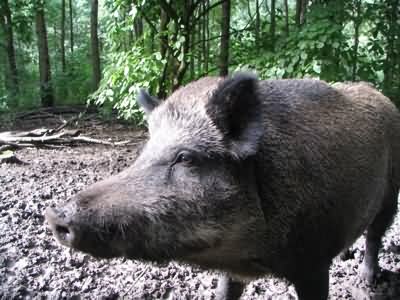Pests
Sus scrofa L. - Pig, Feral Pig, Wild Pig, Wild Boar
Systematic position.
Class Mammalia, order Artiodactyla, family Suidae, genus Sus.Biological group.
Trade animal, pest of crops.Morphology and biology.
The Wild Boar is extraordinarily variable in size, body proportion and coloration. However, all animals have typical stocky shape, with body length 170-205 cm, height up to 100 cm, seldom a little more, and weight usually 60-150 kg (to 300 kg). The body is covered with bristles that are longer and denser in winter. Coloration is light brown or gray, sometimes almost black; piglets are stripy. It is a polygamous species. The age of the first breeding is usually in 18 months for females and 24 months for males. The estrous cycle lasts 21 day. The period of pregnancy lasts 112-120 days. The average size of litters is 4-6 piglets with variation from 3 to 10. Pairing occurs mainly in spring (from April until May). The birth usually takes place in autumn, but it depends on the physiological state of females. Females separate themselves from the group for birth and come back later with piglets who feed on milk until 3 to 4 months of age. It is an omnivorous species with an overwhelming part of the diet including vegetative food; i.e., roots, tubers, grasses, fruits, nuts, seeds, and agricultural crops. In addition, the wild boar consumes invertebrates, carrion, vertebrates, and mollusks. Components of the diet vary throughout the year, depending on energy-rich foods, such as acorns. It is known that these animals can make food migrations. A gregarious life is characteristic of the Wild Boar, except for adult males and females with small piglets.Distribution.
The Wild Boar is a widespread species which populates all Europe northward to Scandinavian Peninsula. In Asia, it lives everywhere to Southern Siberia, Transbaikalia, and the Far East to the north; it populates also tropical continental zone, and such islands as Sulawesi, Java, Sumatra, New Guinea, etc. It is acclimated to a number of places in North and Central America, and in Argentina.Ecology.
The Wild Boar is an ecologically flexible species. It populates many biotopes from semi-desert regions to tropical zone, including woodlands, pastures, steppes, deciduous forests, and agricultural lands of the temperate climate zone. In the limits of the Former USSR, the Wild boar lives practically in the northern part of the area. Predators influence its numbers, especially during winter. The Wolf is the main enemy of the Wild boar in most part of its area. Wolves reduce wild boar livestock in heavy snow winters, killing piglets, swine, and adult females. Relatively recently, the Wild Boar was the main prey of tigers in Transcaucasia, Midle Asia, Kazakhstan, and the Far East. Deep snow cover is the first limiting factor of all abiotic environment factors; short extremities in wild boars prevent movement through deep snow. Other factors worth noting include unstable forage reserve and lean years regarding main food. Poacher hunting, forest fires and fires in reedy and tugai thickets cause death of significant amount of piglets and migration of adults. Large quantities of wild boars perish in deltas of rivers due to exhaustion and starvation while spending many days in water during high floods. Reduction of areas under crops and established weeds and bushes on former fields during the last 15-20 years worsen forage reserve for the Wild Boar.Economic significance.
The Wild Boar is a valuable trade animal, an object of amateur and sport hunting. It damages crops of maize and grain cereals, melon fields and vegetable gardens. The damage is not so much from eating plants as it is from digging up the ground and trampling crops and vegetable gardens. Similar damage is done to pastures, too. However, pest damage by wild boars is usually exaggerated. Only when wild boar numbers are high on small fields, among forests or canes, does an essential loss to cultivated plants occur. Wild boars can destroy plantations and crops by 30% and more in lean years when natural forages are poor. To prevent damage to crops, application of mechanical means of protection in the form of various types of fences including electric ones are recommended; chemical (repellents) and acoustic frightening. Additional fertilizing plots and fodder fields are used as counter measures. The most effective active way is intensive shooting in target dates of hunting, catching of animals, and shooting them on fields. The main strategy is the intensive use of boar livestock management, quantitative and qualitative regulation of wild boar numbers, counting their damage to agriculture.Reference citations:
Anon. 2003-2006. Wild pig (Sus scorfa). FlorAnimal. http://www.floranimal.ru/pages/animal/k/207.html.Danilkin A.A. 2002. Pigs (Suidae). Mammals of Russia and adjacent countries. Мoscow: GEOS, 309 p. (in Russian).
Geptner V.G. Nasimovich A.A., Bannikov A.G. 1961. Mammals of the Soviet Union. V. I. .Artiodactila and Perissodactila.. In: Geptner V.G. and Naumov N.P. eds., Moscow: .Vyshaya shkola., 776 p. (in Russian).
Gromov I.M., Gureev A.A., Novikov G.A., Sokolov I.I., Strelkov P.P., Chapskii K.K. 1963. Mammals of the USSR fauna. Part 2. In: Pavlovskii E.I., ed. Moscow, Leningrad: Izdatel.stvo Akademii Nauk SSSR, 639-1102 p. (in Russian).
Hutchins M., Kleiman D.G., Geist V., and McDade M.C. (eds.). Grzimek.s Animal Life Encyclopedia, 2nd edition. Vol. 15, Mammals IV. Detroit et al.: Farmington Hills, MI: Gale Group, 2003. 472 p.
Ivanova G.I., Varnakov A.P. 1986. Recommendations on prevention of damage caused by wild boars to agriculture. Moscow: Tsentral.naya nauchno-issledovatel.skaya laboratoriya okhotnich.ego khozyaiistva i zapovednikov, 14 p. (in Russian).
Nurgeldyev O.N. 1969. Mammalian ecology of plain Turkmenistan. Panfilov D.A., ed. Ashkhabad: Ilym. 259 p. (in Russian).
Pavlinov, I.Ya., Rossolimo, O.L. 1987. Taxonomy of the USSR mammals. In: Cokolov V.E., ed. Moscow: Izdatel.stvo Moscow University, 284 p. (in Russian).
Sludskii A.A., Baiidavletov R.Zh., Bekenov A., Zhiryakov V.A., Pole V.B., Fadeev V.A., Fedocenko A.K., 1984. Mammalians of Kazakhstan. V.3, part.4. Artiodactila (Cervidae, Moschidae, Suidae) and Perissodactila (Equidae). In: Gvozdev E.V. and Strautman E.I., eds. Alma-Ata: .Nauka. Kazakh SSR, 232 p. (in Russian).
© Saulich M.I.
Photo © User: GerardM (Wikipedia, the free encyclopedia)http://upload.wikimedia.org/wikipedia/commons/6/62/Zwijntje.JPG


